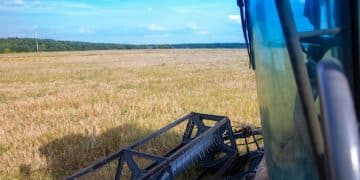USDA Gene Editing Guidelines: What US Farmers Need to Know

The Latest USDA Guidelines on Gene Editing in Agriculture: What Farmers Need to Know Now focus on ensuring that gene-edited crops are regulated no differently than traditionally bred crops, provided they do not pose a plant pest risk, thereby reducing regulatory burdens and fostering innovation in agricultural practices within the US.
The agricultural landscape is constantly evolving, and with advancements in technology, farmers are now presented with innovative tools like gene editing to enhance crop production and resilience. Understanding The Latest USDA Guidelines on Gene Editing in Agriculture: What Farmers Need to Know Now, is crucial for US farmers looking to leverage these technologies while adhering to federal regulations.
Understanding USDA’s Stance on Gene Editing
The United States Department of Agriculture (USDA) plays a pivotal role in shaping the future of agriculture through its policies and regulations. Gene editing, a revolutionary technology with the potential to transform crop production, has garnered significant attention from both the scientific community and policymakers. Navigating the USDA’s stance on gene editing is crucial for farmers aiming to adopt innovative practices while ensuring compliance.
Defining Gene Editing in Agriculture
Gene editing involves making precise alterations to an organism’s DNA, without introducing foreign genes. This technology offers the potential to enhance crop traits such as yield, disease resistance, and nutritional value. Unlike traditional genetic modification, gene editing can often mimic natural mutations, making it a more precise and efficient breeding tool.
Key Principles of the USDA Guidelines
The USDA’s regulations on gene editing are built upon a set of key principles designed to encourage innovation while safeguarding the environment and consumer interests. These principles prioritize risk-based assessments and streamlined regulatory processes, particularly for gene-edited crops that do not pose a heightened risk of plant pest. The USDA seeks to avoid unnecessary regulatory burdens that could stifle innovation in agriculture.
- Focus on product risk rather than the process used to create the product.
- Exempt gene-edited plants from regulation if they could have been developed through traditional breeding methods.
- Emphasize transparency and collaboration among government entities.
These principles aim to provide a clear and predictable pathway for gene-edited crops to reach the market, balancing safety and innovation.
In essence, the USDA’s approach to gene editing is to evaluate the final product for potential risks, rather than scrutinizing the process by which it was created.

Navigating the Regulatory Framework
The regulatory framework surrounding gene editing in agriculture can seem complex. Understanding the different agencies involved and their respective roles is essential for US farmers looking to incorporate gene-edited crops into their operations. The USDA’s guidelines provide a roadmap for navigating this framework, emphasizing transparency and streamlined processes.
Role of Different Government Agencies
Several government agencies, including the USDA, the Environmental Protection Agency (EPA), and the Food and Drug Administration (FDA), share responsibility for regulating gene-edited crops. The USDA focuses on plant pest risk, the EPA regulates pesticides, and the FDA ensures the safety of food products. Understanding each agency’s jurisdiction helps in ensuring that gene-edited crops meet all necessary regulatory requirements.
Exemptions and Streamlined Approvals
The USDA offers exemptions for gene-edited plants that could have been developed through traditional breeding methods, streamlining the approval process and reducing regulatory burdens. This exemption encourages innovation and allows for faster adoption of beneficial crop traits. Farmers should familiarize themselves with the criteria for exemption to ensure their gene-edited crops qualify.
Case Studies of Gene-Edited Crops
Several gene-edited crops have already successfully navigated the regulatory framework and reached the market, demonstrating the practical application of the USDA’s guidelines. These case studies provide valuable insights into the regulatory process and the potential benefits of gene editing in agriculture. Examples include gene-edited soybean varieties with enhanced oil profiles and improved resistance to herbicides.
By understanding the roles of different agencies, farmers can more effectively navigate the regulatory landscape, promoting innovation and compliance.
Benefits of Gene Editing for US Farmers
Gene editing technology offers a wide range of potential benefits for US farmers, from increasing crop yields to reducing the reliance on chemical inputs. Harnessing these benefits requires a clear understanding of the technology and its applications. The latest USDA guidelines aim to facilitate the adoption of gene editing practices that can improve productivity and sustainability.
Enhanced Crop Yields and Resilience
Gene editing can enhance crop traits that are crucial for increasing yields and resilience to environmental stressors. By precisely modifying genes, scientists can develop crops that are more resistant to pests, diseases, and extreme weather conditions. This leads to more stable and predictable yields, enhancing farm profitability.
Reduced Reliance on Chemical Inputs
Gene editing can reduce the need for chemical inputs such as pesticides and herbicides by developing crops with enhanced resistance to pests and weeds. This reduces input costs for farmers and promotes more sustainable agricultural practices, minimizing the environmental impact of farming operations.

Improved Nutritional Value
Gene editing offers the potential to enhance the nutritional value of crops by increasing the levels of essential vitamins, minerals, and antioxidants. This contributes to improving human health and addressing nutritional deficiencies in the population. Gene-edited crops with enhanced nutritional profiles offer added value to consumers and markets.
- Reduced input costs through decreased use of pesticides and herbicides.
- Enhanced crop productivity through increased yields and resilience.
- Improved nutritional value leading to healthier food products.
By leveraging the benefits of gene editing, US farmers can enhance their productivity, sustainability, and profitability.
Overall, gene editing can lead to crops that require fewer resources, resulting in economic and environmental benefits.
Addressing Concerns and Misconceptions
Despite the many potential benefits of gene editing, there are also concerns and misconceptions surrounding the technology. Addressing these concerns is essential for building public trust and ensuring responsible implementation of gene editing practices. Science-based information and transparent communication are key to navigating these discussions.
Safety of Gene-Edited Crops
One of the primary concerns is the safety of gene-edited crops for human consumption and the environment. Extensive research and risk assessments are conducted to ensure that gene-edited crops meet safety standards. The USDA’s regulatory framework emphasizes product-based review, focusing on the traits of the crop rather than the process used to create it.
Environmental Impact
Another concern relates to the potential environmental impact of gene-edited crops, including the unintended effects on biodiversity and ecosystems. Scientific reviews and guidelines aim to minimize these impacts by promoting responsible use. Gene editing can reduce the need for pesticides, potentially benefiting biodiversity.
Ethical Considerations
Ethical considerations also come into play, with discussions around the ownership of gene-edited crops and the potential impact on smallholder farmers. Ensuring equitable access to gene-editing technologies and protecting farmers’ rights are important factors. Transparency and public engagement can help address many ethical considerations.
Addressing these concerns requires open communication, scientific rigor, and a commitment to responsible farming practices.
It’s important to foster dialogue and share evidence-based information to address concerns about safety, environmental impact, and ethical implications.
Practical Steps for Farmers
For US farmers interested in exploring gene editing technologies, there are several practical steps to take to navigate the regulatory landscape and incorporate these innovations into their farming operations. These steps involve understanding the USDA’s guidelines, engaging with experts, and following best practices for crop management.
Engaging with Experts and Resources
Farmers should engage with experts in the field of gene editing, including scientists, regulatory specialists, and agricultural advisors. These experts can provide valuable insights and guidance on the regulatory requirements and best practices for implementing gene editing technologies. Access to reliable resources and information is crucial for making informed decisions.
Compliance with USDA Guidelines
Farmers must adhere to the USDA’s guidelines and regulations when working with gene-edited crops. This includes completing the necessary risk assessments and obtaining any required permits or approvals. Compliance ensures that crops meet safety standards and are eligible for market access.
Best Practices for Crop Management
Implementing best practices for crop management is essential when working with gene-edited crops. This includes following proper planting, irrigation, and pest control techniques to maximize the benefits of gene editing while minimizing any potential risks. Integrated pest management (IPM) strategies can help ensure sustainable and responsible farming practices.
- Consult with experts to gain insights and guidance.
- Comply with USDA guidelines to ensure eligibility for market access.
- Implement best management practices to maximize benefits.
By taking these practical steps, US farmers can responsibly integrate gene editing technologies into their farming operations.
Evaluating Seed Options
Farmers should carefully evaluate seed options from trusted suppliers to ensure they are using high-quality, compliant varieties.
Future Trends in Gene Editing and Agriculture
The field of gene editing is rapidly advancing, and several future trends are likely to shape the future of agriculture. Keeping an eye on these trends is crucial for farmers looking to stay ahead of the curve and leverage the latest innovations in crop production. Continued research, technological advancements, and policy developments will all play a role in shaping the landscape.
Advancements in Gene Editing Tools
Continuous advancements are expected in gene editing tools, such as CRISPR-Cas systems, which will make the technology more precise, efficient, and accessible. These advancements will expand the range of traits that can be edited and reduce the time and cost associated with crop development. Improved tools can accelerate the pace of innovation in agriculture.
Integration with Data Analytics and AI
The integration of gene editing with data analytics and artificial intelligence (AI) will offer new opportunities for optimizing crop traits and management practices. AI can analyze vast amounts of data to identify genes that contribute to desirable traits and predict the performance of gene-edited crops under different environmental conditions. This integration can lead to more targeted and effective breeding programs.
In summary, the future of gene editing holds promise, but will require proactive engagement and continuous learning to navigate.
These advancements will open new possibilities for enhancing crop traits and improving agricultural sustainability.
| Key Aspect | Brief Description |
|---|---|
| 🌱 USDA Guidelines | Focus on product risk rather than process; streamline approvals for low-risk crops. |
| 🚜 Farmer Benefits | Enhanced yields, reduced pesticide use, and improved crop resilience. |
| 🔬 Future Trends | Advancements in gene editing tools and integration with AI for optimized crop traits. |
| 🛡️ Addressing Concerns | Safety assessments, environmental impact reviews, and ethical considerations are essential. |
Frequently Asked Questions
▼
Gene editing involves making precise changes to a plant’s DNA to improve its characteristics, such as yield, pest resistance, or nutritional value. It is different from traditional GMOs.
▼
The USDA regulates gene-edited crops based on whether they pose a plant pest risk. Crops that do not pose such a risk are generally exempt from regulation.
▼
Gene editing can lead to higher yields, reduced pesticide use, improved crop resilience, and enhanced nutritional value, offering economic and environmental benefits.
▼
Yes, gene-edited foods are subject to rigorous safety assessments to ensure they meet safety standards for human consumption, similar to traditionally bred crops.
▼
Farmers can consult with experts, comply with USDA guidelines, implement best management practices, and evaluate seed options to responsibly integrate gene-edited crops.
Conclusion
Staying informed about the latest USDA guidelines on gene editing is essential for US farmers who wish to leverage these innovative technologies. By understanding the regulatory framework, potential benefits, and addressing common concerns, farmers can responsibly incorporate gene editing into their practices, enhancing productivity and sustainability in American agriculture.





